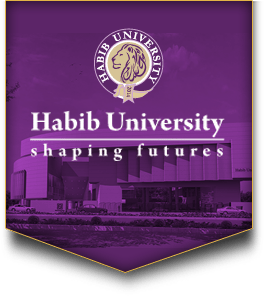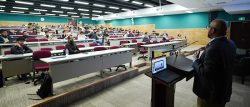Habib University Sophomore Syed Affan Aslam, who accompanied the Computer Science faculty member Dr. Jibran Rashid to the 19th Conference on Quantum Information Processing (QIP 2016), recounts his experience of presenting at a global forum
Let’s rewind and start from the moment I entered the bus heading to the hill station [the Banff Center in Alberta, Canada, where the conference was held]. It was laden with both quantum physicists and computer scientists eager to present and discuss their research work. An aura of creativity, the aesthetics of theoria, poiesis and praxis, were conspicuous. Almost everyone was involved in a technical discussion. Two scientists seated behind me were discussing algebraic topology they wanted to use for their collaborative work on Quantum Information Theory. After 10-15 minutes, I realized that I had embarked upon an intellectual odyssey. For a budding quantum scientist, the experience was memorable and, if I may say so, subliminal.
En route to Banff. Incredible experience in the midst of renowned quantum scientists. @HabibUniversity pic.twitter.com/Dbnw3124N6
— Syed Affan Aslam (@SyedAfphanAslam) January 11, 2016
The azure sky, partially eclipsed by animated clouds, was quite a spectacle. The vista outside, the discussions inside, together shaped a memorable atmosphere. I immersed myself into the moment by perusing a research paper authored by Ämin Baumeler on quantum causality1. The paper was given to me by my research supervisor, Dr. Jibran Rashid, as we intend to work on this problem apropos PR-box correlations. In lay language, if I explain causal order: we intuitively understand that an input precedes an output; what if they both occur simultaneously? It is an interesting question – needless to mention the difficulties in its practical possibility. Anyway, we discussed it for some time and proceeded to take a nap. When I woke up, we had already entered the immediate vicinity of the Banff Center. After 10 or so minutes, the participants queued up to check-in. We received our access cards after a couple of minutes and headed to Llyod Hall (our accommodation).
It was not just my first International Conference, but also my first trip to Banff. Although I lack wanderlust, I could sense – and still remember – a strange longing as I descried its sublime scenery. Coming from an industrialized metropolis polluted with waste and human misery, I found the tranquil ambience of Banff utopic. The awe-inspiring mountains and the snowy waterfall – which would have rushed down the steep hillside had it not been frozen – embellished the overall atmosphere of the hill station. I still feel as if I lost my heart to the place.
Banff centre (the venue for #QIP2016 ). Checked in. Going to the room. @HabibUniversity pic.twitter.com/X0ByI7oi7o
— Syed Affan Aslam (@SyedAfphanAslam) January 11, 2016
On the second day when I woke up – at 5.00 a.m. – I decided to start my day with a reading of the literature required to understand the talks happening on that day. I breezed through the abstracts of the talks available on arXiv as well as the conference’s website. Of course, I wanted to consume as much as I could. The room was beautiful and pleasant; so was the view outside.
Scenic. Sublime @HabibUniversity pic.twitter.com/lb5PSkrRAg
— Syed Affan Aslam (@SyedAfphanAslam) January 11, 2016
When I entered the Kinnear Center, I was surprised to see that almost every participant – whether presenting a poster or giving a talk – was a distinguished researcher from a renowned institution. An identity card dangling around all participants’ neck had their institution’s name written on it. I remember feeling proud that mine read ‘Habib University’.
The conference began shortly. The first talk titled ‘A loop-hole free Bell test’ was delivered by Ronald Hansen on a recent groundbreaking experiment2. The talk was about the experimental realization of a major quantum phenomenon. Hansen’s presentation set the tone and got the ball rolling – the ebullient enthusiasm was reflected by the audience’s wholehearted applause and the interesting questions raised. It was quite clear that most of the participants were Ph.D. or Post-Doc students.
Subsequently, I attended several talks on the different dimensions of quantum computing. My favorite was one on quantum non-locality. Later, we proceeded to a delicious lunch at the dining center. The day ended with some remarkable memories.
The third day began with the promise of an afternoon for leisurely activities. I was excited, as Dr. Rashid and I had decided to take a walking tour of the downtown area, which was around two kilometers away. The rocky, snowy mountains and the beautiful roads offered a wonderful panorama of Banff. Presided over by those brooding peaks, Dr. Rashid and I had some deeply illuminating discussions. After shopping for a bit, we headed back to the Llyod Hall.
The fourth day began with, by turns, excitation and anxiety. I had to present my poster; had to answer the intellectually challenging questions. A seemingly never-ending internal monologue occupied my mind: what would I say when such and such was asked, and so forth. After attending a few talks, I rushed to the first floor of the Kinnear center where my poster was hanging in a room.
The poster presentations began. The participants interested in non-locality swung by my poster, asked stimulating questions, and praised the work we did. They also gave us some very important suggestions, which we are now planning to work on. Most of them inquired about my university and my level of education. They were surprised to hear that I was a sophomore; more than me, they praised Habib University for its remarkable focus on research. I was extremely proud that I was the only undergraduate student who was presenting a poster at such a conference.
The fifth day was the last. After several edifying talks, Dr. Peter Høyer – who had supervised Dr. Rashid’s Ph.D. – gave us a lift back to Calgary. He was a wonderful gentleman. It was quite obvious that he must be a technical genius, but his philosophical insight into science – and especially in scientific pedagogy – was noteworthy. He often used the phrase “thinking about how you are thinking”, which reminded me of the quintessence of Yohsin i.e., thoughtful self-cultivation. According to Dr. Høyer, when you pursue research papers, you should try to deconstruct the insight of the author: how is he approaching the problem and applying mathematics, you should ask. He greatly encouraged me and the initiative taken by Habib University.
The experience I had is unforgettable. I still cannot clearly trace the lines of causality that led me to Banff: I had never even dreamed about attending a worldwide conference on quantum information processing. It just happened. I am greatly thankful to Dr. Rashid, the Habib family, and the entire community who helped me realize a dream I had not yet seen. I have returned highly motivated and will endeavor to make all of us proud again.
I would like to acknowledge Habib University for providing travel support and the QIP 2016 organizers for providing registration waiver and accommodation support.




